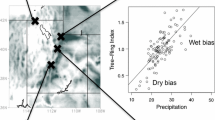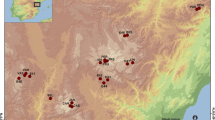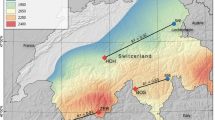Abstract
Tree rings are widely considered to be a reliable proxy record of variations in climate and soil moisture. Here, using data from the Midwest United States (US), we provide documentation of a deteriorating relationship between radial tree growth and drought that is consistent across multiple species and locations. We find that traditional methods for drought reconstructions produce models that have rapidly declining validation statistics in recent decades. Split-sample calibration-verification that uses the first and second halves of the record can be problematic, as those two samples may not represent a sufficiently wide range of soil moisture conditions. To investigate this problem, we develop a randomized validation procedure that generates an empirical distribution of calibration and validation statistics. We place validation statistics derived from traditional methods in the generated distribution and compare them to a stratified approach that ensures each calibration model is composed of a sample that includes both dry and wet years. We find that the deteriorating relationship between tree growth and soil moisture is an artifact of the absence of drought over an extended period of time. A model that forces each calibration period to contain extreme drought years is statistically validated.. Nonetheless, if the current pluvial continues in the Midwest US, the linear relationship between tree rings and soil moisture will likely continue to deteriorate to the point where tree rings in the region will have a reduced ability to estimate past drought conditions.






Similar content being viewed by others
References
Allen CD, Macalady AK, Chenchouni H, Bachelet D, McDowell N, Vennetier M, Kitzberger T, Rigling A, Breshears DD, Hogg ET, Gonzalez P (2010) A global overview of drought and heat-induced tree mortality reveals emerging climate change risks for forests. For Ecol Manag 259:660–684
Barber VA, Juday GP, Finney BP (2000) Reduced growth of Alaskan white spruce in the twentieth century from temperature-induced drought stress. Nature 405:668–673
Biondi F, Waikul K (2004) DENDROCLIM2002: a C++ program for statistical calibration of climate signals in tree-ring chronologies. Comput Geosci 30:303–311
Brzostek ER, Dragoni D, Schmid HP, Rahman AF, Sims D, Wayson CA, Johnson DJ, Phillips RP (2014) Chronic water stress reduces tree growth and the carbon sink of deciduous hardwood forests. Glob Chang Biol 20:2531–2539
Büntgen U, Frank D, Wilson R, Carrer M, Urbinati C, Esper J (2008) Testing for tree-ring divergence in the European Alps. Glob Chang Biol 14:2443–2453
Choat B, Jansen S, Brodribb TJ, Cochard H, et al. (2012) Global convergence in the vulnerability of forests to drought. Nature 491:752–755
Cook ER, Krusic PJ (2004) North American summer PDSI reconstructions. IGBP PAGES/World Data Center for Paleoclimatology Data Contribution Series, 45
Cook ER, Peters K (1981) The smoothing spline: a new approach to standardizing forest interior tree-ring width series for dendroclimatic studies. Tree-Ring Bull 41:45–53
Cook ER, Meko DM, Stahle DW, Cleaveland MK (1999) Drought reconstructions for the continental United States. J Clim 12:1145–1162
Cook ER, Anchukaitis KJ, Buckley BM, D’Arrigo RD, Jacoby GC, Wright WE (2010) Asian monsoon failure and megadrought during the last millennium. Science 328:486–489
D’Arrigo RD, Kaufmann RK, Davi N, Jacoby GC, Laskowski C, Myneni RB, Cherubini P (2004) Thresholds for warming-induced growth decline at elevational tree line in the Yukon territory, Canada. Glob Biogeochem Cycles 18:GB3021
Dai A (2013) Increasing drought under global warming in observations and models. Nat Clim Chang 3:52–58
De Grandpré L, Tardif JC, Hessl A, Pederson N, Conciatori F, Green TR, Oyunsanaa B, Baatarbileg N (2011) Seasonal shift in the climate responses of Pinus sibirica, Pinus sylvestris, and Larix sibirica trees from semi-arid, north-central Mongolia. Can J For Res 41:1242–1255
Driscoll WW, Wiles GC, D’Arrigo RD, Wilmking M (2005) Divergent tree growth response to recent climatic warming, Lake Clark National Park and preserve, Alaska. Geophys Res Lett 32:L20703
Esper J, Frank D (2009) Divergence pitfalls in tree-ring research. Clim Chang 94:261–266
Ford TW (2014) Precipitation anomalies in eastern-Central Iowa from 1640–present. J Hydrol 519:918–924
Fritts HC (1976) Tree rings and climate. Academic Press, New York
Hoerling M, Eischeid J, Kumar A, Leung R, Mariotti A, Mo K, Schubert S, Seager R (2014) Causes and predictability of the 2012 Great Plains drought. Bull Am Meteorol Soc 95:269–282
Jacoby GC, D’Arrigo RD (1995) Tree ring width and density evidence of climatic and potential forest change in Alaska. Glob Biogeochem Cycles 9:227–234
Jacoby GC, Lovelius NV, Shumilov OI, Raspopov OM, Karbainov JM, Frank DC (2000) Long-term temperature trends and tree growth in the Taymir region of northern Siberia. Quat Res 53:312–318
Klein T, Yakir D, Buchmann N, Grünzweig JM (2014) Towards an advanced assessment of the hydrological vulnerability of forests to climate change-induced drought. New Phytol 201:712–716
Li B, Nychka DW, Ammann CM (2007) The “Hockey Stick” and the 1990s: a statistical perspective on reconstructing hemispheric temperatures. Tellus Ser A 59:591–598. doi:10.1111/j.1600-0870.2007.00270.x
Lloyd AH, Bunn AG (2007) Responses of the circumpolar boreal forest to 20th century climate variability. Environ Res Lett 2:045013
Lloyd AH, Fastie CL (2002) Spatial and temporal variability in the growth and climate response of treeline trees in Alaska. Clim Chang 52:481–509
Mallya G, Zhao L, XC S, Niyogi D, Govindaraju RS (2013) 2012 Midwest drought in the United States. J Hydrol Eng 18:737–745
Manzoni S, Vico G, Katul G, Palmroth S, Jackson RB, Porporato A (2013) Hydraulic limits on maximum plant transpiration and the emergence of the safety–efficiency trade-off. New Phytol 198:169–178
Martínez-Vilalta J, Poyatos R, Aguadé D, Retana J, Mencuccini M (2014) A new look at water transport regulation in plants. New Phytol 204:105–115
Maxwell JT (2016) The benefit of including rarely used species in dendroclimatic reconstructions: a case study using Juglans nigra in south-central Indiana. Tree-Ring Res, USA
Maxwell RS, Hessl AE, Cook ER, Pederson N (2011) A multispecies tree ring reconstruction of Potomac River streamflow (950–2001). Water Resour Res 47:W05512
Maxwell JT, Harley GL, Matheus TJ (2015) Dendroclimatic reconstructions from multiple co-occurring species: a case study from an old-growth deciduous forest in Indiana, USA. Int J Climatol 35:860–870
Meko D (1997) Dendroclimatic reconstruction with time varying predictor subsets of tree indices. J Clim 10:687–696
Melvin TM, Briffa KR (2008) A “signal-free” approach to dendroclimatic standardisation. Dendrochronologia 26:71–86
Mishra V, Cherkauer KA (2010) Retrospective droughts in the crop growing season: implications to corn and soybean yield in the Midwestern United States. Agric For Meteorol 150:1030–1045
Nash J, Sutcliffe JV (1970) River flow forecasting through conceptual models part I—A discussion of principles. J Hydrol 10:282–290
Palmer WC (1965) Meteorological Drought, Weather Bureau Research Paper No. 45. Washington, DC: US Department of Commerce
Pederson N, Bell AR, Knight TA, et al. (2012) A long-term perspective on a modern drought in the American southeast. Environ Res Lett 7:014034
Pederson N, Bell AR, Cook ER, et al. (2013) Is an epic pluvial masking the water insecurity of the greater New York City region? J Clim 26:1339–1354
Pederson N, Hessl AE, Baatarbileg N, Anchukaitis KJ, Di Cosmo N (2014) Pluvials, droughts, the Mongol empire, and modern Mongolia. Proc Natl Acad Sci U S A 111:4375–4379
Pisaric MF, Carey SK, Kokelj SV, Youngblut D (2007) Anomalous 20th century tree growth, Mackenzie Delta, northwest territories, Canada. Geophys Res Lett 34:L05714
Roman DT, Novick KA, Brzostek ER, Dragoni D, Rahman F, Phillips RP (2015) The role of isohydric and anisohydric species in determining ecosystem-scale response to severe drought. Oecologia 179:641–654
Saladyga T, Maxwell RS (2015) Temporal variability in climate response of eastern hemlock in the Central Appalachian Region. Southeast Geogr 55:143–163.
Vicente-Serrano SM, Beguería S, López-Moreno JI (2010) A multiscalar drought index sensitive to global warming: the standardized precipitation evapotranspiration index. J Clim 23:1696–1718
Wahl ER, Smerdon JE (2012) Comparative performance of paleoclimate field and index reconstructions derived from climate proxies and noise-only predictors. Geophys Res Lett 39:L06703
Wigley TL, Briffa KR, Jones PD (1984) On the average value of correlated time series, with application in dendroclimatology and hydrometeorology. J Clim Appl Meteorol 23:201–213
Wilhite DA, Svoboda MD, Hayes MJ (2007) Understanding the complex impacts of drought: a key to enhancing drought mitigation and preparedness. Water Resour Manag 21:763–774
Wilmking M, Juday GP, Barber VA, Zald HS (2004) Recent climate warming forces contrasting growth responses of white spruce at treeline in Alaska through temperature thresholds. Glob Chang Biol 10:1724–1736
Acknowledgments
We thank Dale Weigel at the U.S. Forest Service, personnel at the Indiana Division of Natural Resources Division of Nature Preserves, and the Nature Conservancy, and Dr. Matthew Therrell for assistance to access our study sites. Thanks to James Dickens, Trevis Matheus, Kayla Pendergrass, Karly Schmidt, Matthew Wenzel, Nicolas Batchos, and Luke Wylie for field assistance and Kayla Pendergrass for lab assistance. We also are grateful to Dr. Stockton Maxwell, Dr. Bryan Black, and Dr. Evan Larson for thoughtful discussions that improved this manuscript. Lastly, we thank three anonymous reviewers for their insightful comments and Dr. Michael Mastrandrea for organizational advice.
Author information
Authors and Affiliations
Corresponding author
Electronic supplementary material
ESM 1
Supplemental Material (PDF 1.30 mb)
Rights and permissions
About this article
Cite this article
Maxwell, J.T., Harley, G.L. & Robeson, S.M. On the declining relationship between tree growth and climate in the Midwest United States: the fading drought signal. Climatic Change 138, 127–142 (2016). https://doi.org/10.1007/s10584-016-1720-3
Received:
Accepted:
Published:
Issue Date:
DOI: https://doi.org/10.1007/s10584-016-1720-3




